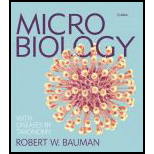
Introduction:
Bacteria are prokaryotic and unicellular organisms that either present in a cluster of cells or in isolated forms. The cell wall of bacteria is made up of peptidoglycan layer and they lack membrane-bound organelles. Bacteria can grow either in presence of oxygen (aerobes) or in the absence of oxygen (anaerobes).
Answer to Problem 1MC
Correct answer:
An aerobic bacterium can be grown in a Petri plate in laboratory conditions.
Therefore, option (b) is correct.
Option (b) is given as “an aerobic bacteria”.
Explanation of Solution
Justify the reason for the correct statement:
Bacterial cells can be cultured in the laboratory by giving them a growth media consisting required amount of nutrients and oxygen by the bacterial cell. A bacterial colony can be grown on agar medium or Petri plate. An aerobic bacterium can grow in presence of oxygen on a Petri plate containing growth medium.
Hence, option (b) is correct.
Justify the reasons for the incorrect statements:
Option (a) is given as “an anaerobic bacterium”.
Anaerobic bacterium needs maintained conditions to grow. The anaerobic bacteria grow only in the absence of oxygen and in an inoculated Petri dish that contains a seal to prevent entry of oxygen. They cannot grow in presence of oxygen in a Petri plate. Hence, it is a wrong answer.
Option (c) is given as “viruses on an agar surface”.
Viruses can grow on special growth media like bacterial cells or on tissues. They cannot be grown on agar in Petri plate. Hence, it is a wrong answer.
Option (d) is given as “all of the above”.
The aerobic bacterium can be grown on Petri plate but other options: anaerobic bacterium and viruses are incorrect as they cannot be grown on Petri plate. Hence, it is a wrong answer.
Hence, options (a), (c), and (d) are incorrect.
The aerobic bacterium which needs oxygen to grow can be cultured on growth medium in Petri plate.
Want to see more full solutions like this?
Chapter 6 Solutions
Microbiology with Diseases by Taxonomy (5th Edition)
- Which of the following is NOT correctly matched? A. Halophile – microbe that can grow in an environment with high osmotic pressure (e.g., salt) B. None of the other four answers (all are correctly matched) C. Agar – complex polysaccharide from seaweed used as a solidifying agent in culture media D. Colony – a population of microbial cells arising from a single cell or spore or from a group of attached cells E. Capnophile – microbe requiring an elevated molecular oxygen (O2) environment for optimal growtharrow_forwardWhich one of the following is the most resistant microorganism for sterilization: Select one: a. Lipid enveloped viruses b. Gram negative bacteria c. Gram positive bacteria d. Mycobacteriumarrow_forwardWhich of the following medium is considered an enriched medium? a. LB b. T-soy c. Nutrient d. Chocolate agar plate d. None of the abovearrow_forward
- A medium in which all the components are known is: A. Minimal medium B. Synthetic or defined medium C. Selective medium D. Complete medium E. Complex medium F. Differential medium G. General purpose mediumarrow_forwardWhich of the following can be used to distinguish one colony from another on an agar plate? Select all that apply. a. Shape b. Color c. Gram stain d. Cell arrangement e. Size f. Elevation g. Margin h. Texturearrow_forwardAgar is superior to gelatin as a solidifying agent because agar a. does not melt at room temperature b. solidifies at 75°C c. is not usually decomposed by microorganisms d. both a and carrow_forward
- Agar is added to media. a. many kinds of bacterial O b. All kinds.of viral no kinds of microbial O d. All kinds of microbialarrow_forwardFor each of the following situations, describe how bacteria on these growth. media would appear on the plate: A. On MacConkey agar, a bacterium that grows on the medium but is negative for lactose fermentation B. On EMB agar, a bacterium that grows on the medium but is positive for lactose fermentation C. On mannitol salt agar, a bacterium that failed to grow on the medium D. On mannitol salt agar, a bacterium that grew on the medium and fermented mannitolarrow_forwardThe MIC is the of a drug that is required to inhibit growthof a microbe.a. largest concentration b. standard dose c. smallest concentration d. lowest dilutionarrow_forward
- Which of the following is similar to a block of highly purified “jello-like” substance that is not completely solid and has numerous pores throughout its structure? A. Micropipette b. Restriction enzymes c. Agarose d. Negative electrode please give correct answerarrow_forwardMicrobes that can be grown on agar petri dish include A. Bacteria B. Virus C. Fungi D. Protests E. Helminths.arrow_forwardIn spread plate method, colonies form within the agar and agar surface. In pour plate method, previously prepared agar plates are not required. a. First statement is TRUE, Second statement is FALSE. b. First statement is FALSE, Second statement is TRUE. c. Both statements are TRUE. d. Both statements are FALSE.arrow_forward
 Comprehensive Medical Assisting: Administrative a...NursingISBN:9781305964792Author:Wilburta Q. Lindh, Carol D. Tamparo, Barbara M. Dahl, Julie Morris, Cindy CorreaPublisher:Cengage Learning
Comprehensive Medical Assisting: Administrative a...NursingISBN:9781305964792Author:Wilburta Q. Lindh, Carol D. Tamparo, Barbara M. Dahl, Julie Morris, Cindy CorreaPublisher:Cengage Learning
